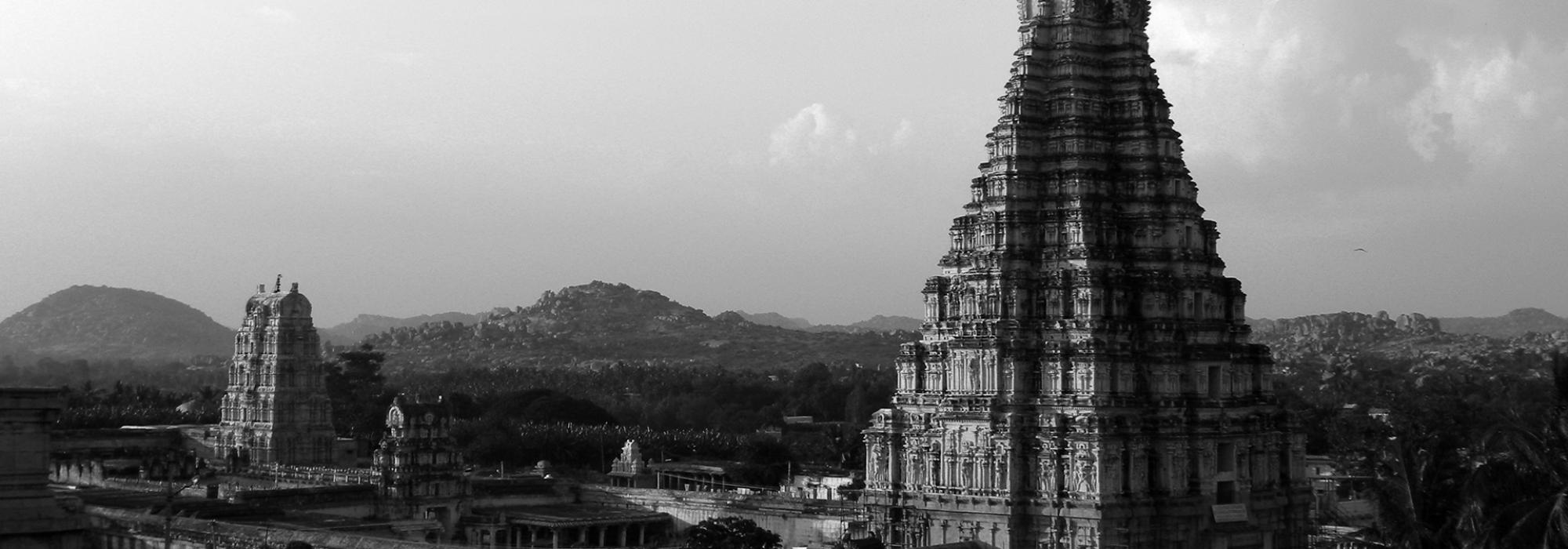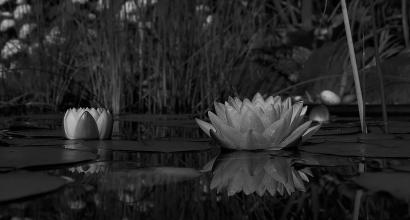Sanatana dharma has upheld the ideal of the 'vanasuma' – the wild flower spreading its fragrance without hankering after personal fame. However, this shunning of fame, while rewarding in one’s sadhana, can cause quite a problem when it comes to historicity.
Any discussion on the dates of famous personages like Kalidasa, Shankara, Gaudapada and even deities like Rama and Krishna is invariably mired in controversy and debate. In some cases, even the identity and place of the person is in question. Compounding this behavior are historians and researchers with not-so-covert agendas – spurred in no small measure by institutions of dubious intentions or misplaced priorities.
Unfortunately for us, Vidyaranya is renowned enough to be yet another academic battleground. As a consolation however, we do have sources that allow us to glean much about his life and deeds.
Vidyaranya, well known in his पूर्वाश्रम as Madhavacharya, was the eldest son of the meritorious couple of Mayana and Shrimati. His partner in many works – including the famous commentary on the Vedas – Sayana, was his younger brother. It is also known that he had another brother named Bhoganatha and a sister named Singala. This family belonged to the भारद्वाज-गोत्र, the तैत्तिरीय-शाखा of the Yajurveda and followed the बोधायन-सूत्र. It is obvious that they were a स्मार्त-ब्राह्मण family following the precepts of advaita.
It is held by a few that Vidyaranya was different from Sayana’s elder brother, Madhavacharya. Sufficient evidence in this case disproves such a notion. For want of space, this will not be discussed in this series.
The 'ण' at the end of the names of सायण and मायण points out that Vidyaranya’s place of birth was कर्णाटक (Karnataka). The Andhra tradition uses 'न' in such cases. Such usages are rare in Tamil Nadu. However, Vidyaranya had intimate knowledge of both Telugu and Tamil, in addition to Kannada. It can also be said with some certainty that he belonged to the Hoysala-Karnataka sect that has a significant presence in Karnataka to this day.
Given the fact that King Harihara established an अग्रहार village near Sringeri called Vidyaranyapura (probably because it was the birth place of his teacher) and that the families of Harihara and Bukka lived around present day Chikkamagaluru, it would be prudent to claim the region surrounding Sringeri as the birthplace of Vidyaranya. It should also not be forgotten that Sringeri was where Sri Vidyatirtha and Sri Bharati Tirtha, the heads of the श्री-मठ and the gurus of Vidyaranya resided for the most part. Hampi is another region that could possibly have been his birthplace.
Currently, we do not know of an established date of birth that is beyond debate. Popular wisdom says that Vidyaranya was a contemporary of Vedanta Deshika, the celebrated vishishtadvaita philosopher. It is because of Vedanta Deshikar’s well-established dates of birth and death that several scholars, including D V Gundappa, hold 1269 CE to be the year of birth of Vidyaranya. However, several problems arise if this were to be chosen as the date of birth.
To start with, 1269 CE would make Vidyaranya around seventy years old at the time of the establishment of the Vijayanagar Empire (1336 CE – this date is beyond doubt and we have abundant evidence for this from inscriptions). Again, inscriptions establish that Madhavacharya held the role of prime minister to Harihara till around 1375 CE. This would mean that Vidyaranya did not renounce the world till he was over a hundred years old – which would be implausible, in spite of his known capacity for superhuman achievements. (Note that the simultaneous holding of the post of prime-minister and that of a head of a matha is forbidden by sanyasa-dharma). Recent researches from P N Shastri and Swami Kalyanananda Bharati show that Wednesday, 11 April 1296 CE – (दुर्मुख-नाम-संवत्सर वैस्हाख शुद्ध सप्तमी) can be regarded as the date of birth.
In the remainder of this piece, I will refer to Vidyaranya in his पूर्वाश्रम as Madhava-Vidyaranya to differentiate him from other people with the name Madhavacharya.
Gurus
From their joint achievements, it can be inferred that Sayana and Madhava-Vidyaranya learnt and grew together. This shows that Sayana was only slightly younger than his elder brother. As Mayana Bhatta, their father, was himself a learned personage, we can surmise that their initial education happened at the feet of their father. Their first formal preceptor in the shastras was Srikantha, who lived somewhere around Sringeri. Srikantha (or श्रीकण्ठ-नाथ) was also well versed in the shaiva-darshanas and a renowned teacher.
Madhava-Vidyaranya had higher studies under Swami Shankarananda, who, being a sannyasin in the Shankarite tradition, himself has composed several advaitic works such as Sutra-dipika, Atma-purana, Viveka-sara, and Gita-tatparya-bodhini.
Madhava-Vidyaranya was formally initiated into sanyasa by Sri Bharati Tirtha (or भारती-कृष्ण-तीर्थ). Sri Bharati Tirtha also appointed Madhava-Vidyaranya as his successor to the leadership of the Sringeri matha. Sri Bharati Tirtha is renowned for the composition of several advaitic works such as the Dipa-pentad of the Panchadashi, Drg-drshya-viveka and Vaiyasika-nyaya-mala. He was the leader of the Sringeri matha between 1257 CE and 1377 CE (before Madhava-Vidyaranya) after being nominated by his illustrious predecessor Sri Vidyatirtha. The extent of devotion Madhava and Sayana had towards Sri Bharati Tirtha is well-depicted by the following shlokas in the Parashara-madhaviya and the Kala-madhaviya respectively.
लब्धाम्-आकलयन् प्रभाव-लहरीं श्री-भारती-तीर्थतः
"Having obtained the wave of strength from Sri Bharati Tirtha..."
सर्वेषां च प्रथम-सुखदं भारती-तीर्थम्-आहुः |
तद्भावान्-मे विपुल-मनसो निर्णये शक्तिरस्ति ||
"...the giver of the most important bliss – Sri Bharati Tirtha… by whose grace I have obtained ability in decision making…"
It came as no surprise that the devotion of the brother-duo was reciprocated by their guru in no small measure.
But, the biggest influence for Madhava-Vidyaranya in the form of inspiration, guidance, and philosophical soundness was Sri Vidyatirtha. Being the pontifical head of the Sringeri matha, Sri Vidyatirtha had great renown as a yogi par excellence and a repository of vedantic wisdom and yet did not deign to compose a single work, absorbed as he was in the bliss of brahman. There can be no further statement of his greatness than that he was worshiped by great savants like Sri Bharati Tirtha and Madhava-Vidyaranya. In all likelihood, he led Madhava-Vidyaranya and Sayana to brahmananda by imparting not just upadeshas of great mantras such as श्री-विद्या, but also by guidance in yoga and in the advaitic path of jnana.
In essence, Sri Vidyatirtha was not just teacher of the shastra, but a guru who taught the ideal of life to the brother-duo. It is no surprise then, that Sayana and Madhava-Vidyaranya expressed their gratitude in glowing terms such as the following verse from the Anubhuti-prakasha (Madhava-Vidyaranya) –
अन्तः प्रविष्टेति शास्तेति योऽन्तर्यामी श्रुतीरितः |
सोऽस्मान् मुख्य-गुरुः पातु विद्यातीर्थ-महेश्वरः ||
"May He, our most important guru – our moksha guru, the great lord Vidya Tirtha, who is praised by the veda as the inner controller, protect us!"
(The word “मुख्य गुरु” shows us that there were several preceptors and that Sri Vidyatirtha was the most important amongst them).
A similar sentiment is expressed in the introduction to the Veda-bhashya –
यस्य निःश्वसितं वेदा यो वेदेभ्योऽखिलं जगत् |
निर्ममे तमहं वन्दे विद्यातीर्थ-महेश्वरम् ||
"I bow to the great lord Vidyatirtha, whose outgoing breath was the veda and who created the entire universe from the veda!"
A popular prayer goes – 'गुरुः साक्षात् परं ब्रह्म' (the teacher is indeed the supreme brahman). From the preceding verse, we see that Sri Vidya Tirtha was considered thus by Sayana and Madhava-Vidyaranya. It was to honor such a great personage that Vidyaranya undertook the building of that most famous mark of Sringeri, the temple of Vidyashankara. The seal of the Sringeri matha is also in the name of Vidyashankara.
To be continued...










































